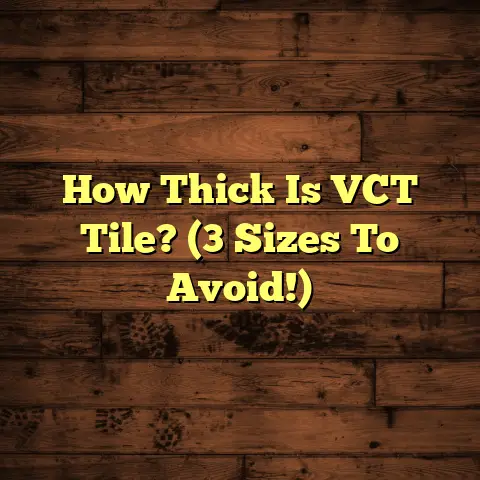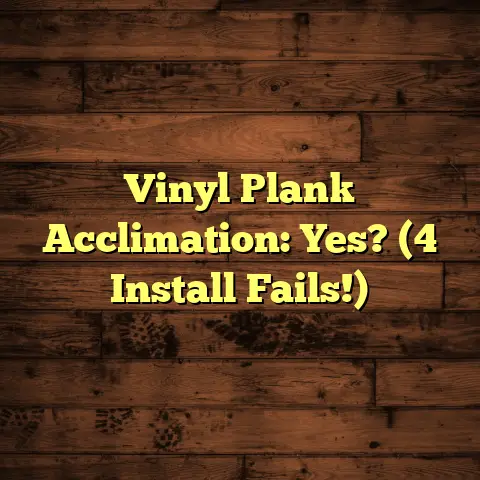Glued Wood Floor Removal: Right Tool? (5 Machines!)
A common misconception is that all flooring removal is the same, and any tool will do.
Trust me, after years in the flooring biz, I can tell you that’s just plain wrong, especially when you’re dealing with glued wood floors.
Many homeowners, and even some pros, underestimate the challenge.
You wouldn’t use a butter knife to cut down a tree, right?
Same idea here.
Using the wrong tool can lead to a ton of extra work, damage your subfloor, and cost you money.
So, let’s dive into what makes glued wood flooring so tricky and, more importantly, what tools will make your life a whole lot easier.
Section 1: Understanding Glued Wood Flooring
Okay, so what exactly is glued wood flooring?
It’s exactly what it sounds like: wood flooring that’s directly adhered to the subfloor using, well, glue!
This is different from nailed-down floors, which use fasteners, or floating floors, which click together and “float” above the subfloor.
Think of it like this:
- Nailed: Think hammer and nails – traditional and strong.
- Floating: Think puzzle pieces – easy to install and remove.
- Glued: Think superglue and a stubborn toddler – a real commitment!
Now, the type of adhesive used can vary.
Over the years, I’ve seen everything from basic construction adhesives to super-strong epoxies.
These adhesives have different characteristics and bond strengths.
Some of the common types include:
- Acrylic Adhesives: These are water-based and generally have a lower VOC (Volatile Organic Compound) content.
They’re good for general use but might not be the strongest. - Polyurethane Adhesives: These are moisture-cured and create a very strong, durable bond.
They’re often used in high-traffic areas. - Epoxy Adhesives: These are two-part systems that create an incredibly strong and chemical-resistant bond.
They’re often used in commercial settings.
The bond strength is crucial.
A weak adhesive might let go with a bit of persuasion, but a strong one will fight you every step of the way.
So, why is removing glued wood flooring such a pain?
Several factors contribute to the difficulty:
- Strong Adhesion: The glue is designed to hold the flooring in place for years, sometimes decades.
- Subfloor Damage: Improper removal can easily damage the subfloor, leading to costly repairs.
- Time and Labor: It can be incredibly time-consuming and physically demanding.
- Dust and Debris: Ripping up glued floors creates a ton of dust and debris.
I’ve seen jobs that should have taken a day turn into a week-long nightmare because the wrong tools were used.
Trust me, you want to avoid that.
Section 2: The Importance of Choosing the Right Tools
Let’s talk about why picking the right tools is so important.
It’s not just about making the job easier; it’s about efficiency, safety, and protecting your investment.
Imagine trying to remove a glued-down floor with just a hammer and chisel.
Sounds fun, right?
Wrong!
Using the right tools has a huge impact on:
- Efficiency: The right tool will remove the flooring faster and with less effort.
- Subfloor Preservation: Specialized tools are designed to minimize damage to the subfloor.
- Safety: Using the correct tools reduces the risk of injury.
- Cost: While specialized tools might have an upfront cost, they can save you money in the long run by reducing labor time and preventing costly repairs.
Now, let’s talk about the potential damage that can occur if you use the wrong tools.
I’ve seen it all:
- Damaged Subfloor: Gouges, cracks, and uneven surfaces.
- Increased Labor Time: Spending days, even weeks, on a job that should have taken hours.
- Muscle Strain and Injury: Flooring removal is physically demanding, and using the wrong tools can increase the risk of injury.
- Frustration and Stress: Let’s be honest, nobody enjoys a frustrating DIY project.
That’s why specialized tools are so important.
They’re designed specifically for the task of removing glued wood flooring, taking into account the challenges and potential pitfalls.
Section 3: Overview of Essential Machines for Glued Wood Floor Removal
Alright, let’s get to the good stuff!
Here are five key machines that can make removing glued wood flooring a whole lot easier.
I’ve used them all, and I’ll give you my honest opinion on each.
Machine 1: Floor Scraper
The floor scraper is a classic for a reason.
It’s a simple but effective tool for lifting and removing flooring materials.
You’ve got two main types: manual and powered.
- Manual Floor Scraper: This is basically a long handle with a blade at the end.
You use your body weight to push the blade under the flooring and lift it up.
It’s cheap and reliable, but it requires a lot of elbow grease. - Powered Floor Scraper: This is a motorized version that does the work for you.
It vibrates or oscillates the blade, making it much easier to remove flooring.
It’s more expensive, but it’s worth it if you have a large area to cover.
The blades are key.
Different blades are designed for different types of adhesives and flooring materials.
Some common types include:
- Straight Blades: These are good for general use and for removing flooring that’s not too tightly bonded.
- Angled Blades: These are designed to get under the flooring and lift it up.
- Beveled Blades: These are good for removing thin-set mortar and other hard adhesives.
I’ve found that a good quality scraper with a variety of blades is essential for any flooring removal job.
Machine 2: Rotary Hammer
A rotary hammer is a powerful tool that combines a hammer and a drill.
It’s great for breaking up stubborn adhesives and for removing flooring that’s tightly bonded to the subfloor.
The rotary hammer uses a hammering action to break up the adhesive while the drill action helps to loosen the flooring.
It’s much more powerful than a regular drill, and it can make quick work of even the toughest jobs.
To maximize performance for flooring removal, you’ll want to use the right attachments and settings.
Some common attachments include:
- Chisel Bits: These are used to break up the adhesive and lift the flooring.
- Scaling Chisels: These are wider than regular chisels and are used to remove large areas of flooring.
- Bushing Tools: These are used to roughen up the subfloor after the flooring has been removed.
I usually recommend using a rotary hammer in conjunction with a floor scraper.
The rotary hammer can be used to break up the adhesive, and then the floor scraper can be used to lift and remove the flooring.
Machine 3: Floor Removal Machine (or Tile Removal Machine)
This is the big daddy of flooring removal.
A dedicated floor removal machine is a powerful and efficient tool designed specifically for removing flooring materials.
It’s basically a souped-up floor scraper on wheels.
These machines have a powerful motor that drives a blade or chisel, which is used to lift and remove the flooring.
They’re much faster and more efficient than manual methods, and they can save you a lot of time and effort.
One of the key features of these machines is the depth adjustment.
This allows you to control how deep the blade cuts into the subfloor, which is important for preventing damage.
They are also designed for ease of maneuverability.
Even though they are heavy, they are usually equipped with wheels and handles that make them easy to move around.
I’ve used floor removal machines on large commercial jobs, and they’ve saved me a ton of time and money.
They’re definitely an investment, but they’re worth it if you do a lot of flooring removal.
Machine 4: Heat Gun
A heat gun is a simple but effective tool for softening adhesives before removal.
It works by blowing hot air onto the adhesive, which softens it and makes it easier to remove.
Heat guns are particularly useful for removing adhesives that have become brittle over time.
The heat helps to restore the adhesive’s flexibility, making it easier to scrape or peel off.
Safety is paramount when using a heat gun.
Always wear gloves and eye protection, and be careful not to overheat the adhesive, as this can release harmful fumes.
When using a heat gun, start by holding it a few inches away from the adhesive and moving it back and forth.
Once the adhesive has softened, you can use a scraper or other tool to remove it.
I often use a heat gun in conjunction with a floor scraper.
The heat gun softens the adhesive, and then the floor scraper is used to lift and remove the flooring.
Machine 5: Oscillating Multi-Tool
An oscillating multi-tool is a versatile tool that can be used for a variety of tasks, including flooring removal.
It uses a rapidly oscillating blade to cut, sand, and scrape materials.
The versatility of an oscillating tool comes from the wide variety of blades that are available.
Different blades are designed for different materials and applications.
Some common blades for flooring removal include:
- Scraper Blades: These are used to scrape away adhesive and other materials.
- Saw Blades: These are used to cut through flooring materials.
- Grout Removal Blades: These are used to remove grout from between tiles.
I find an oscillating multi-tool particularly useful for getting into tight spaces and for removing small areas of flooring.
It’s also great for detail work, such as removing adhesive from around pipes and fixtures.
Section 4: Comparing the Machines
Okay, so we’ve covered the basics of each machine.
Now, let’s compare them side-by-side.
Here’s a table that breaks down the pros and cons of each tool:
As you can see, each machine has its strengths and weaknesses.
The best tool for the job will depend on the specific situation.
Now, let’s hear from some other pros.
I asked a few of my colleagues for their thoughts on these machines:
- “I swear by my floor removal machine,” says Mark, a commercial flooring contractor.
“It’s a lifesaver on big jobs.
It’s expensive, but it pays for itself in time saved.” - “I use a rotary hammer for almost every flooring removal job,” says Sarah, a residential contractor.
“It’s great for breaking up tough adhesives, and it’s not too expensive.” - “I always keep an oscillating multi-tool in my truck,” says Tom, a handyman.
“It’s perfect for small jobs and for getting into tight spaces.”
Section 5: Case Studies and Real-World Applications
Let’s look at a few real-world examples of how these machines can be used to remove glued wood flooring:
Case Study 1: Removing Glued Hardwood from a Living Room
A homeowner wanted to replace the glued hardwood flooring in their living room.
The adhesive was very strong, and the flooring was difficult to remove.I recommended using a rotary hammer to break up the adhesive, followed by a floor scraper to lift and remove the flooring.
This combination of tools made the job much easier and faster.
* Case Study 2: Removing Glued Tile from a KitchenA restaurant owner wanted to replace the glued tile flooring in their kitchen.
The tile was very old, and the adhesive had become brittle over time.I recommended using a heat gun to soften the adhesive, followed by an oscillating multi-tool to remove the tile.
The heat gun helped to restore the adhesive’s flexibility, and the oscillating multi-tool was perfect for getting into tight spaces.
* Case Study 3: Removing Glued Carpet from an Office BuildingA property manager wanted to remove the glued carpet from an office building.
The carpet was very large, and the adhesive was very strong.I recommended using a floor removal machine to remove the carpet.
The floor removal machine was much faster and more efficient than manual methods, and it saved the property manager a lot of time and money.
In each of these cases, the right tool made a significant difference in the success of the project.
Conclusion
So, there you have it!
Glued wood floor removal can be a challenging task, but with the right tools, it can be a whole lot easier.
Remember, choosing the right machine is crucial for efficiency, safety, and protecting your investment.
While there are many tools available, the task’s complexity demands careful consideration of the right equipment to achieve the best results.
Take the time to understand your options and choose the tools that are best suited for your specific needs.
It’ll save you time, money, and a whole lot of frustration.
Happy flooring!




